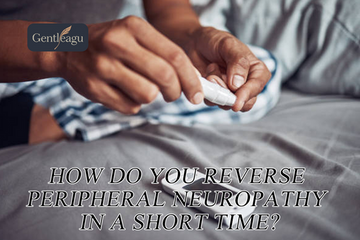How Do You Reverse Peripheral Neuropathy in a Short Time?
Peripheral neuropathy, characterized by nerve damage in the hands, feet, and legs, can lead to symptoms like numbness, tingling, and pain. While full reversal in a short time isn't always possible, early intervention, proper management, and lifestyle adjustments can alleviate symptoms and support nerve repair. Below are steps to help manage and potentially reverse neuropathy effectively.
1. Manage Blood Sugar Levels (For Diabetic Neuropathy)
Why It Helps: High blood sugar damages blood vessels and nerves over time. Stabilizing glucose levels can slow or reverse neuropathy progression.
What to Do:
- Monitor glucose levels regularly to stay within the recommended range.
- Follow a low-glycemic diet rich in whole grains, lean protein, and vegetables. Avoid refined sugars and carbohydrates.
- Exercise regularly to improve circulation and insulin sensitivity.
- Take prescribed medications or insulin as directed by your healthcare provider.
2. Support Nerve Repair with Nutrition
Why It Helps: Nutrients like B vitamins and antioxidants are critical for nerve regeneration and reducing inflammation.
Key Nutrients:
- Vitamin B12: Supports nerve health and prevents damage. Sources: meat, fish, eggs, fortified cereals, or supplements.
- Alpha-Lipoic Acid (ALA): Reduces oxidative stress and improves nerve function. Found in spinach, broccoli, or supplements.
- Acetyl-L-Carnitine: Promotes nerve repair and reduces pain. Sources: red meat, dairy, or supplements.
- Omega-3 Fatty Acids: Reduce inflammation and support nerve regeneration. Sources: fatty fish, walnuts, or flaxseeds.
- Magnesium: Relieves cramping and supports muscle and nerve health. Found in leafy greens, seeds, and nuts.
Pro Tip: Consult your doctor before starting supplements to ensure proper dosage.
3. Engage in Physical Therapy and Nerve Stimulation
Why It Helps: Physical therapy strengthens muscles, promotes circulation, and helps manage symptoms like numbness or tingling.
Effective Therapies:
- Physical Therapy: Improves flexibility, strength, and balance.
- Transcutaneous Electrical Nerve Stimulation (TENS): Uses electrical currents to reduce pain and stimulate nerve repair.
- Vibration Therapy: Can enhance circulation and sensory nerve recovery.
Pro Tip: Work with a licensed therapist for tailored exercises.
4. Manage Pain with Medication
Why It Helps: While medications won’t reverse damage, they help manage pain and discomfort, allowing for better quality of life.
Common Medications:
- Antidepressants: E.g., amitriptyline or duloxetine, for nerve pain relief.
- Anti-seizure Drugs: Gabapentin and pregabalin calm overactive nerves.
- Topical Treatments: Capsaicin cream or lidocaine patches for localized relief.
Pro Tip: Use medications alongside lifestyle changes for optimal results.
5. Improve Circulation and Reduce Inflammation with Lifestyle Changes
Why It Helps: Better blood flow nourishes nerves, while reducing inflammation prevents further damage.
Lifestyle Tips:
- Exercise Daily: Activities like walking, swimming, or cycling promote circulation.
- Stop Smoking: Smoking restricts blood flow, worsening neuropathy.
- Massage Therapy: Stimulates blood flow and eases discomfort.
- Elevate Your Feet: Reduces swelling and improves blood flow at the end of the day.
Pro Tip: Aim for 30 minutes of gentle exercise daily to improve nerve health.
6. Explore Alternative Therapies
Why It Helps: Complementary therapies can reduce pain and promote nerve recovery.
Popular Options:
- Acupuncture: May alleviate neuropathic pain and improve nerve function.
- Chiropractic Care: Helps with spinal alignment and nerve function.
- Herbal Remedies: Curcumin (from turmeric) and alpha-lipoic acid have anti-inflammatory properties.
Pro Tip: Combine alternative therapies with traditional treatments for better results.
7. Wear Supportive Gear
Why It Helps: Specialized socks and footwear reduce pressure, improve circulation, and protect against injury.
Suggestions:
- Compression Socks: Improve blood flow and reduce swelling.
- Diabetic Socks: Offer padding and moisture control to prevent irritation.
Pro Tip: Avoid tight or restrictive footwear that can worsen symptoms.
Final Thoughts: Manage Peripheral Neuropathy Effectively
While immediate reversal may not be possible, these steps can significantly reduce symptoms and promote nerve health. Early intervention and consistent care—such as managing blood sugar, improving circulation, and supporting nerve repair with the right nutrients—are essential for progress.
If symptoms persist or worsen, consult a healthcare provider to create a personalized treatment plan. Remember, small changes can make a big difference in managing peripheral neuropathy and improving your overall quality of life.
